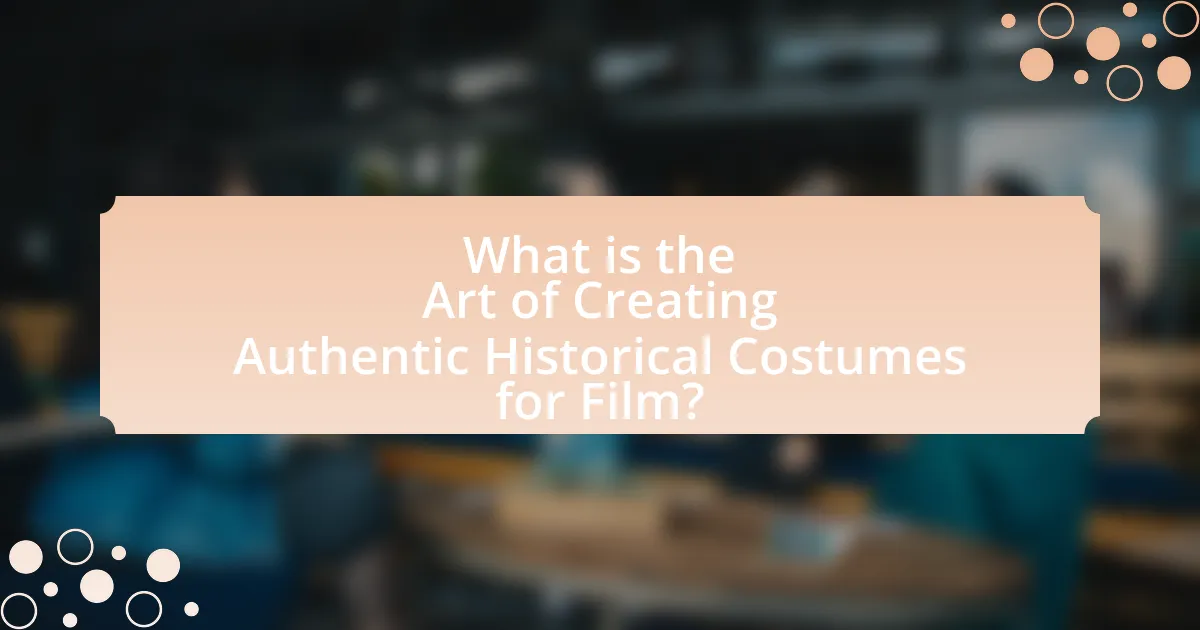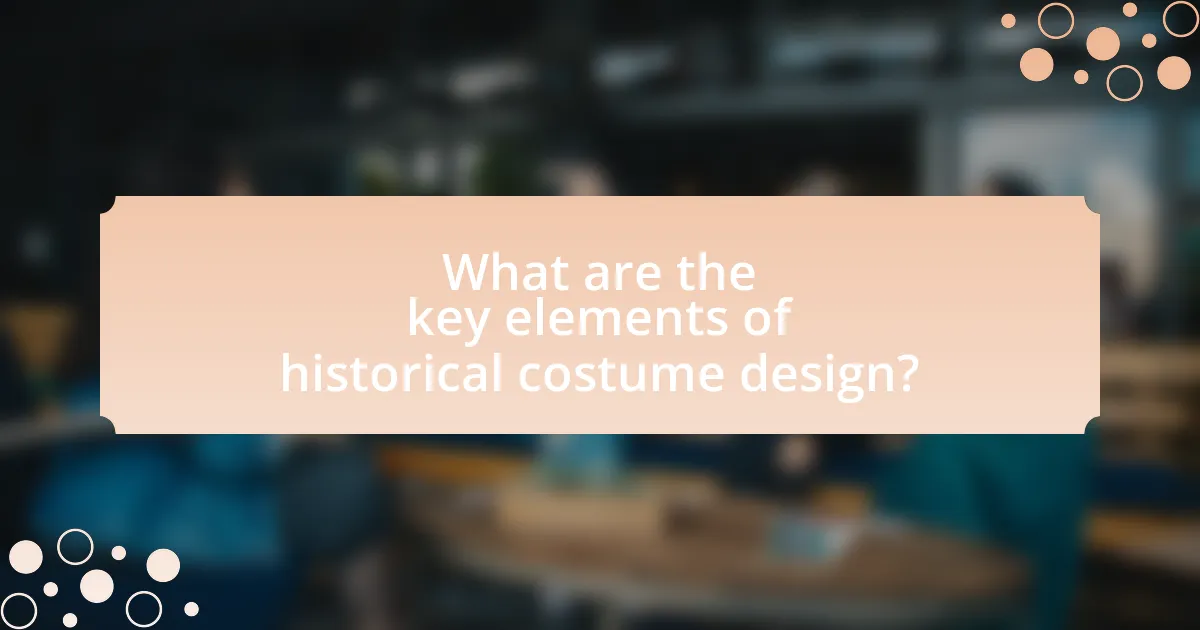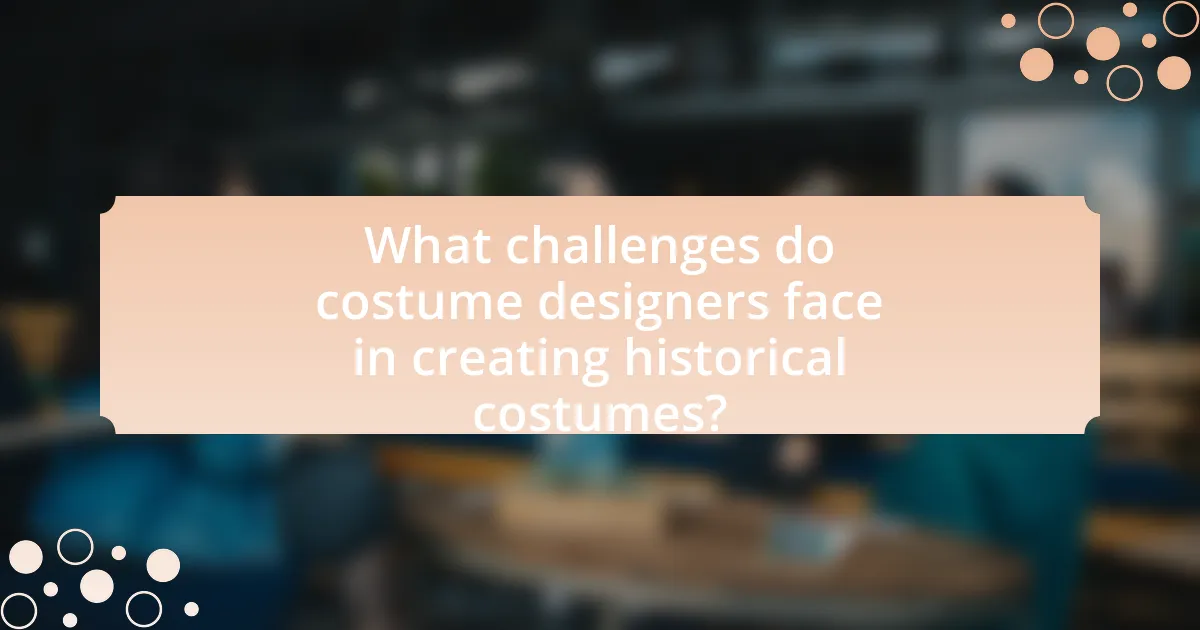The article focuses on the art of creating authentic historical costumes for film, emphasizing the importance of meticulous research, skilled craftsmanship, and attention to detail in accurately representing clothing styles from specific time periods. It outlines the research methods essential for authenticity, including primary source analysis and ethnographic studies, and discusses how historical contexts influence costume choices. The significance of authenticity in enhancing storytelling and audience perception is highlighted, along with the challenges faced by costume designers, such as budget constraints and the balance between creativity and historical accuracy. Key elements of historical costume design, including fabric choices, color palettes, and the psychological effects of color, are also examined, providing a comprehensive overview of the processes and considerations involved in this specialized field.

What is the Art of Creating Authentic Historical Costumes for Film?
The art of creating authentic historical costumes for film involves meticulous research, attention to detail, and skilled craftsmanship to accurately represent the clothing styles of specific time periods. Costume designers study historical texts, paintings, and artifacts to ensure that fabrics, colors, and silhouettes reflect the era being depicted. For instance, the use of period-appropriate materials, such as wool or silk, and techniques like hand-sewing or dyeing, enhances authenticity. Additionally, successful historical costumes contribute to character development and storytelling by visually grounding the narrative in its historical context, as seen in films like “Pride and Prejudice,” where costumes were carefully crafted to reflect the Regency era’s fashion.
How does the process of creating historical costumes begin?
The process of creating historical costumes begins with extensive research into the specific time period and culture being represented. This research involves studying historical texts, visual references, and existing garments to ensure accuracy in design and materials. For example, costume designers often reference museum collections and period-specific illustrations to gather insights into fabric types, colors, and construction techniques used during that era. This foundational research is crucial for achieving authenticity in the final costume design.
What research methods are essential for authenticity in costume design?
Historical research methods are essential for authenticity in costume design. These methods include primary source analysis, such as examining original garments, textiles, and period illustrations, which provide direct evidence of historical styles and materials. Additionally, secondary research through scholarly articles and books on fashion history offers context and interpretation of trends and cultural significance. Ethnographic studies can also be valuable, as they explore the social and cultural practices surrounding clothing in specific historical periods. For instance, the book “Costume and Fashion: A Complete History” by James Laver provides comprehensive insights into the evolution of clothing styles, reinforcing the importance of thorough research in achieving authenticity.
How do historical contexts influence costume choices?
Historical contexts significantly influence costume choices by dictating the styles, materials, and colors that reflect the societal norms and values of a specific time period. For instance, during the Victorian era, costumes often featured corsets and layered fabrics, which symbolized social status and modesty. Additionally, the use of specific colors and patterns was often tied to cultural significance; for example, the use of black in mourning attire was a reflection of societal customs surrounding death and grief. These elements are crucial for filmmakers aiming to create authentic representations of historical periods, as they help convey the narrative and emotional depth of the characters within their specific contexts.
Why is authenticity important in historical costume design?
Authenticity is crucial in historical costume design because it ensures that the visual representation accurately reflects the time period and culture being depicted. Accurate costumes enhance the storytelling by providing viewers with a believable context, which is essential for immersion in the narrative. For instance, films like “Pride and Prejudice” (2005) and “The Favourite” (2018) utilized meticulous research into historical garments, resulting in costumes that not only captured the aesthetic of the era but also conveyed social status and character development. This attention to detail helps audiences connect with the characters and the historical setting, reinforcing the film’s credibility and emotional impact.
What impact does authenticity have on audience perception?
Authenticity significantly enhances audience perception by fostering trust and engagement. When historical costumes are accurately represented, audiences are more likely to connect emotionally with the narrative, as they perceive the film as credible and respectful of the source material. Research indicates that viewers often rate films higher when they believe the costumes reflect true historical accuracy, which can lead to increased viewer satisfaction and a stronger overall impact of the film. For instance, a study published in the Journal of Film and Video found that audiences rated films with authentic period costumes as more immersive, demonstrating that authenticity directly influences how viewers interpret and enjoy the cinematic experience.
How does authenticity contribute to storytelling in film?
Authenticity enhances storytelling in film by grounding narratives in believable contexts that resonate with audiences. When films incorporate authentic elements, such as accurate historical costumes, they create a more immersive experience, allowing viewers to connect emotionally with characters and events. Research indicates that films with high authenticity ratings, particularly in costume design, often receive better audience engagement and critical acclaim, as seen in productions like “The Crown,” which meticulously recreates historical attire to reflect the era’s social dynamics. This attention to detail not only enriches the visual storytelling but also reinforces the film’s credibility, making the narrative more impactful and relatable.

What are the key elements of historical costume design?
The key elements of historical costume design include accuracy, fabric choice, silhouette, color palette, and cultural context. Accuracy ensures that costumes reflect the specific time period and location, which is essential for authenticity in film. Fabric choice involves selecting materials that were available and commonly used during the era, such as wool, linen, or silk, which influences the overall look and feel of the costume. Silhouette refers to the shape and structure of garments, which varies significantly across different historical periods, impacting how characters are perceived. The color palette must align with historical dyeing techniques and societal norms of the time, enhancing visual storytelling. Lastly, cultural context involves understanding the social, political, and economic factors that influenced clothing styles, ensuring that costumes resonate with the historical narrative. These elements collectively contribute to creating believable and immersive historical representations in film.
How do fabric choices affect the authenticity of costumes?
Fabric choices significantly impact the authenticity of costumes by influencing their visual appearance, texture, and historical accuracy. For instance, using period-appropriate materials such as wool, linen, or silk can replicate the look and feel of garments from specific eras, thereby enhancing the overall authenticity. Historical research indicates that fabrics like cotton became widely used in the 19th century, while earlier periods relied more on natural fibers, which informs costume designers about appropriate selections for different time periods. Additionally, the drape and weight of fabrics can affect how costumes move and fit on actors, further contributing to the believability of the portrayal.
What types of fabrics were commonly used in different historical periods?
In different historical periods, various types of fabrics were commonly used, reflecting the available resources and technological advancements of the time. For instance, in ancient Egypt, linen was predominantly used due to its availability from flax plants, while in medieval Europe, wool became the primary fabric because of its warmth and durability. The Renaissance period saw the introduction of silk, which was prized for its luxurious texture and was often used by the wealthy. In the 18th century, cotton gained popularity with the advent of the Industrial Revolution, making it more accessible to the general population. Each of these fabrics not only served practical purposes but also indicated social status and cultural identity, as evidenced by historical records and archaeological findings.
How do fabric textures influence the overall look of a costume?
Fabric textures significantly influence the overall look of a costume by affecting its visual appeal, draping, and how it interacts with light. Different textures, such as smooth silk or rough burlap, create distinct aesthetic qualities that can evoke specific historical periods or character traits. For instance, a costume made from luxurious velvet conveys opulence and status, while a garment crafted from coarse wool suggests practicality and ruggedness. The choice of fabric texture can also impact the silhouette and movement of the costume, as heavier materials may create a structured look, while lighter fabrics allow for fluidity and grace. Historical accuracy in costume design often relies on selecting appropriate textures that reflect the era’s materials, enhancing authenticity and viewer immersion.
What role does color play in historical costume design?
Color plays a crucial role in historical costume design by conveying social status, cultural identity, and emotional context. In various historical periods, specific colors were associated with particular meanings; for instance, purple was often reserved for royalty in ancient Rome due to the expensive dye derived from mollusks. Additionally, color choices reflect the technological advancements of the time, such as the introduction of synthetic dyes in the 19th century, which expanded the palette available to designers. Historical accuracy in color not only enhances the visual authenticity of costumes but also aids in storytelling by visually representing characters’ roles and relationships within their societal context.
How can color palettes reflect the time period accurately?
Color palettes can reflect the time period accurately by utilizing specific hues and combinations that were prevalent during that era. Historical research indicates that color choices in clothing were influenced by the availability of dyes, cultural significance, and social status. For example, in the 18th century, vibrant colors like indigo and cochineal red were popular due to the trade of these dyes, while muted earth tones were common in earlier periods due to limited dye technology. Additionally, the psychological and cultural associations of colors, such as the use of white for purity in Victorian times, further anchor color palettes to their respective historical contexts. Thus, by aligning color choices with documented dye practices and cultural meanings, filmmakers can create costumes that authentically represent the intended time period.
What are the psychological effects of color in costume design?
The psychological effects of color in costume design significantly influence audience perception and character interpretation. Colors evoke emotions and associations; for example, red can symbolize passion or danger, while blue often conveys calmness or sadness. Research indicates that colors can affect mood and behavior, as demonstrated in a study by Andrew Elliot and Markus Maier, published in the journal “Emotion,” which found that red enhances performance in detail-oriented tasks but can also increase anxiety. This understanding allows costume designers to strategically select colors that align with character arcs and narrative themes, enhancing storytelling through visual cues.

What challenges do costume designers face in creating historical costumes?
Costume designers face several challenges in creating historical costumes, primarily related to accuracy, material sourcing, and budget constraints. Achieving historical accuracy requires extensive research into the specific time period, including clothing styles, fabrics, and social norms, which can be time-consuming and complex. Additionally, sourcing authentic materials that match historical textiles can be difficult, as many original fabrics are no longer produced. Budget constraints often limit the ability to create intricate designs or acquire high-quality materials, forcing designers to make compromises that can affect the authenticity of the costumes. These challenges highlight the intricate balance between artistic vision and practical limitations in the field of costume design for historical films.
How do budget constraints impact costume authenticity?
Budget constraints significantly limit the ability to achieve costume authenticity in film. When financial resources are restricted, costume designers often resort to cheaper materials and less intricate designs, which can compromise historical accuracy. For instance, a study by the Costume Society of America highlights that productions with higher budgets can afford authentic fabrics and skilled artisans, while lower-budget films frequently use synthetic materials that do not accurately reflect the period’s aesthetics. This disparity in resources directly affects the visual representation of characters and settings, leading to a less authentic portrayal of historical contexts.
What are some cost-effective methods for achieving authenticity?
Cost-effective methods for achieving authenticity in historical costumes include utilizing thrift stores for sourcing materials, employing digital fabric printing for accurate patterns, and repurposing existing garments. Thrift stores often provide vintage clothing and fabrics at lower prices, allowing for authentic looks without high costs. Digital fabric printing enables precise reproduction of historical patterns, reducing the need for expensive custom textiles. Repurposing garments can also save money while maintaining authenticity, as it allows for the adaptation of existing pieces to fit the desired historical period. These methods have been successfully used in various film productions, demonstrating their effectiveness in creating authentic representations while managing budget constraints.
How can designers balance creativity with historical accuracy under budget limitations?
Designers can balance creativity with historical accuracy under budget limitations by prioritizing essential historical elements while allowing for innovative interpretations. This approach involves researching key historical features, such as fabrics, colors, and silhouettes, that define the period, and then creatively adapting these elements using cost-effective materials or techniques. For instance, using modern fabrics that mimic historical textures can maintain authenticity while reducing costs. Additionally, designers can focus on a few standout pieces that capture the essence of the era, rather than attempting to replicate every detail, thus allowing for creative expression within financial constraints. This method has been successfully employed in various film productions, where limited budgets necessitated a focus on impactful design choices that still respected historical context.
What are common misconceptions about historical costume design?
Common misconceptions about historical costume design include the belief that costumes must be entirely accurate to the period, ignoring the need for artistic interpretation. Designers often adapt historical garments for practical reasons, such as comfort and movement, which can lead to deviations from strict historical accuracy. Additionally, there is a misconception that all historical costumes are based solely on existing artifacts; in reality, many designs are informed by research, artistic license, and the narrative context of the film. For instance, films like “The Tudors” blend historical elements with modern aesthetics to enhance storytelling, demonstrating that authenticity can coexist with creative expression.
How do modern interpretations differ from historical realities?
Modern interpretations of historical realities often prioritize aesthetic appeal and narrative coherence over strict adherence to historical accuracy. For instance, filmmakers may choose vibrant colors and exaggerated styles in costumes to enhance visual storytelling, diverging from the muted palettes and practical designs that characterized actual historical garments. This approach can be seen in films like “The Tudors,” where costumes are designed to attract contemporary audiences rather than reflect the true attire of the 16th century, which included more subdued colors and simpler cuts. Additionally, modern interpretations frequently amalgamate elements from different time periods for dramatic effect, leading to a blend of styles that did not coexist historically, as seen in productions like “Game of Thrones.” Such creative liberties can distort public perception of history, as viewers may conflate these stylized representations with factual accounts of the past.
What are the risks of anachronism in costume design?
The risks of anachronism in costume design include undermining historical accuracy, confusing the audience, and damaging the credibility of the production. Historical accuracy is crucial for immersing viewers in a specific time period; anachronistic costumes can disrupt this immersion by introducing elements that did not exist during that era. For example, using modern fabrics or styles in a film set in the 18th century can lead to viewer confusion regarding the authenticity of the narrative. Additionally, anachronisms can harm the production’s credibility, as audiences may perceive a lack of research or attention to detail, which can detract from the overall quality of the film.
What best practices should be followed for successful historical costume creation?
Successful historical costume creation requires thorough research, accurate material selection, and attention to detail. Researching the specific time period, cultural context, and social norms ensures authenticity in design. For instance, studying primary sources like paintings, photographs, and written accounts from the era provides insight into clothing styles and fabrics used. Selecting appropriate materials, such as period-accurate fabrics and trims, enhances the costume’s authenticity; for example, using wool for medieval garments or silk for 18th-century attire reflects historical accuracy. Additionally, meticulous attention to detail in construction techniques, such as hand-sewing or using period-specific patterns, further solidifies the costume’s authenticity. These practices collectively contribute to creating costumes that are not only visually accurate but also resonate with the historical context they represent.
How can collaboration with historians enhance costume authenticity?
Collaboration with historians enhances costume authenticity by providing accurate historical context and details that inform design choices. Historians possess specialized knowledge about the materials, styles, and cultural significance of clothing from specific time periods, which ensures that costumes reflect the true essence of the era being depicted. For instance, a historian’s insight into the fabrics used in the 18th century can guide costume designers in selecting appropriate textiles, thereby increasing the overall authenticity of the production. This collaboration not only enriches the visual representation but also contributes to a deeper understanding of the historical narrative being portrayed.
What tips can help designers stay organized during the costume creation process?
Designers can stay organized during the costume creation process by implementing a structured workflow that includes detailed planning, effective communication, and systematic documentation. Establishing a timeline with specific milestones helps designers track progress and manage deadlines efficiently. Utilizing digital tools, such as project management software, allows for real-time collaboration and updates among team members, ensuring everyone is aligned on tasks and responsibilities. Additionally, maintaining a comprehensive costume database that catalogs fabrics, sketches, and historical references aids in quick retrieval of information, streamlining the design process. These strategies are supported by industry practices that emphasize the importance of organization in achieving high-quality, authentic costume designs for film.